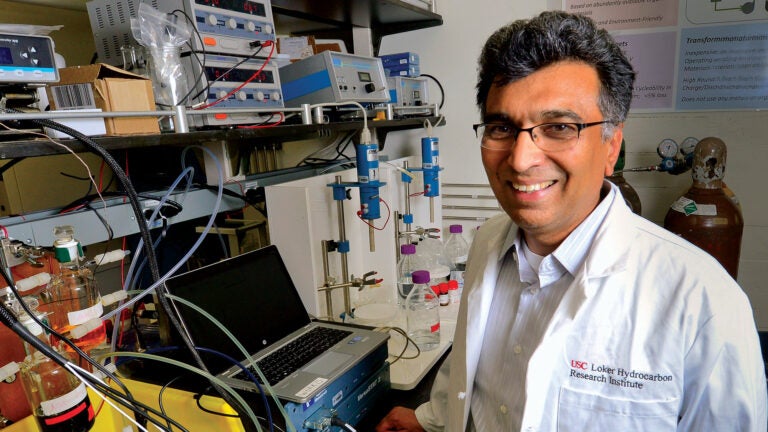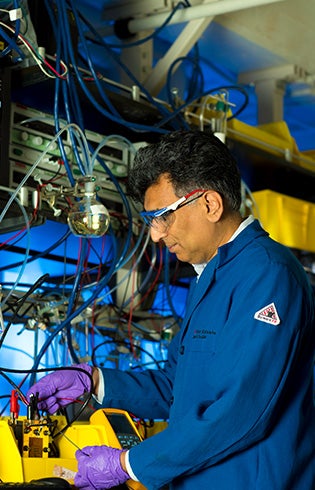
Chemist’s research advanced energy storage solutions and powered Mars rovers
Sri Narayan, professor of chemistry and scientific director of the Loker Hydrocarbon Research Institute at the USC Dornsife College of Letters, Arts and Sciences, whose research transformed fuel cell, battery and sustainability technologies, died on May 24. He was 63.
Narayan was an accomplished scientist, with over 80 journal publications and 50 patents.
“He was an exceedingly good thinker. He could slice through a problem really well,” says G. K. Surya Prakash, George A. and Judith A. Olah Nobel Laureate Chair in Hydrocarbon Chemistry, professor of chemistry and chemical engineering and materials science and Loker Hydrocarbon Research Institute director. “He was also tremendously optimistic about everything: life, science, people. His leadership is a great loss to the Loker Hydrocarbon Research Institute.”
Narayan was born in Mumbai, India, in 1959. He was raised by his father, uncles, and grandmother after his mother passed away when he was six. He was passionate about geography and science, especially chemistry, from an early age.
He completed a bachelor’s degree in chemistry in 1979 at India’s University of Madras, where an inspiring chemistry professor urged him to pursue his passion for the subject. In 1981, he received a master’s degree in chemistry from the Indian Institute of Technology Madras (IIT). While at IIT, he met his future wife, Nagarajan Vaidehi. She was drawn to his extensive knowledge of science as well as his generosity toward others.
“He was a very kind and helpful student to all of his classmates, often staying into the late-night hours to help others complete their lab experiments,” says Vaidehi, a professor and chair of the Department of Computational and Quantitative Medicine at City of Hope in Duarte, California.

The two wed in 1986 and had a daughter, Priyanka Narayan, who later followed in her father’s footsteps with a degree in chemistry from Stanford University and a PhD from the University of Cambridge in the United Kingdom. She is now Stadtman Tenure Track Investigator at the National Institutes of Health.
In 1988, Sri Narayan completed his PhD in electrochemistry at the Indian Institute of Science in Bangalore, India. He was then a post-doctoral fellow at the University of Exeter in the U.K. In 1990, he was awarded a Resident Research Associateship of the National Research Council to work at NASA’s Jet Propulsion Laboratory (JPL) in Pasadena, California.
During his two decades at JPL, Narayan collaborated with Prakash and the late USC Dornsife chemist and Nobel laureate George Olah to co-develop a novel direct methanol fuel cell technology for use as a power source for military and commercial applications. He also led the Electrochemical Technologies Group at JPL, which created the low-temperature lithium-ion batteries that powered rovers sent to the surface of Mars starting in 1997.
This innovation was crucial to NASA’s Mars Exploration Program, says Prakash, who first met Narayan while the two collaborated on fuel cell and battery projects at JPL. “NASA’s Mars program would not have happened without his contributions,” he says.
Narayan joined USC Dornsife in 2010 and turned his attention to the challenge of developing better battery systems to store the large amount of energy generated from solar and wind sources.
Electrical energy storage has proven to be a major sticking point in the transition to green energy. Solar and wind can generate huge amounts of electrical energy, but to fully replace fossil fuels, this energy must be available at all times, not just when the sun is shining or the wind is blowing. Current electricity storage solutions are often expensive to build, prone to fire or reliant on rare materials.
One of Narayan’s focuses was lithium-sulfur batteries, which can hold more energy than standard lithium-ion batteries, use more abundant materials and are less costly. Narayan made progress in improving their short life cycle, helping to make them competitive on the market as a rechargeable battery option.
He also worked on advancing redox-flow batteries, which store energy captured from renewables by charging large tanks of chemical solutions. The electricity in the chemicals can then be extracted and used later for power. In 2020, he published a paper on his redox-flow battery, which uses less expensive and readily available materials.
Recently he had begun new research alongside doctoral student Sara Spears investigating a method to produce iron and steel that results in far fewer carbon emissions than current technologies. He also helped develop sustainable, rechargeable batteries with long life cycles using aqueous iron-nickel.
“Sri had a way of viewing molecular electrochemistry problems very differently than we see in popular approaches and of pushing us out of the ‘box’ of herd mentality. He made me cross-examine much of the popular lore of electrocatalysis,” says Travis Williams, professor of chemistry.
Narayan was elected a fellow of The Electrochemical Society in 2012. In 2021, he was inducted into the prestigious National Academy of Inventors.
“The goal of my research and inventions is to address the global challenge of achieving net-zero carbon emissions through the pervasive use of renewable energy in all spheres of human activity,” he said at the time. “I want my work on batteries to reach the neglected segments of the world population who have no access to electricity.”

It was his upbringing in India, where many still live below the poverty line and lack reliable access to electricity, which especially inspired him. “He had seen poverty in India, and it can be very brutal. Those are things you think back on when you come to the United States and achieve success,” says Prakash. “He really wanted to build technology that could help third-world countries, not just the United States.”
Narayan was also a devoted teacher and mentor to his graduate students. He took a personal approach, providing life advice and staying in touch with them after graduation.
“When my parents came to visit the U.S. from India, he was kind enough to invite them to lunch. He assured my parents that he would take care of me,” says Debanjan Mitra ’19, who received his PhD in chemistry from USC Dornsife under Narayan’s mentorship. He is now an electrochemical engineer at Saft America. “He was a father figure who helped me navigate my personal life.”
A sense of compassion influenced many aspects of Narayan’s life. He volunteered on weekends at a senior center and at the Society for the Blind. Even his commute hours were a chance to connect with others. “He loved talking to his fellow passengers on the Metro Gold Line and the USC shuttle and learning about their lives,” says Vaidehi.
Narayan enjoyed music and played the harmonica as well as two kinds of Indians drums, the mridangam and tabla. He liked hiking in the San Gabriel Mountains and once summited Mount Wilson on Father’s Day with his daughter. He also taught Vedanta, a type of Hindu philosophy, to middle-school students.
Narayan continued his research, teaching and mentoring despite several years of difficult cancer treatments. On Earth Day, just before his final chemotherapy treatment, he spoke for over an hour to the Southern California Section of the American Chemical Society about his research focused on the green energy transition.
Narayan was a thoughtful scientist and generous human who will be sorely missed by colleagues, friends and family, Vaidehi says. “Narayan was always motivated by the ability of his work to help others.”
Narayan is survived by Vaidehi, daughter Priyanka, son-in-law Shivan, and grandsons Ishaan and Sahil.